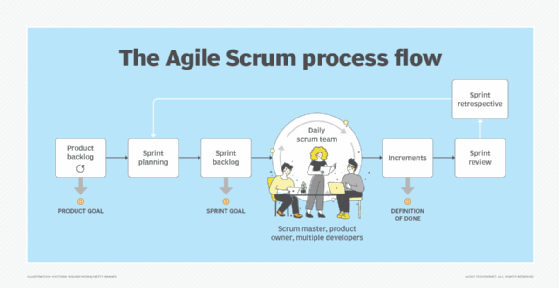
Getty Images
Product backlog vs. sprint backlog: What's the difference?
The sprint backlog and product backlog are important elements of Scrum and essential to iterative and incremental development. Here's how they are distinct and also work together.
The key difference between the sprint backlog and the product backlog is that the sprint backlog represents the work developers expect to complete in the next few weeks, while the product backlog represents the work required to complete the product.
In Scrum, products are developed both incrementally and iteratively.
Development is incremental because a team of developers collectively works on a few product backlog items at a time -- presenting them to the client once they meet the definition of done -- and continuously adds them to the product under development.
Scrum is also said to be iterative because the process of selecting product backlog items, working on them and completing them happens in every sprint, and this cycle repeats until the product is finished.
What is the sprint backlog?
The unit of iteration in Scrum is called a sprint. A sprint typically lasts two to three weeks and never more than a month. To begin a sprint, the team articulates an overarching goal for the sprint. Developers then examine the long list of product backlog items and select the ones they believe can be completed within the sprint. They also create a plan to ensure those items are delivered.
The sprint goal, the selected items and the actionable plan are collectively referred to as the sprint backlog.
The sprint backlog is not set in stone. Teams can add or remove items based on personnel capacity, completion rates and how effectively the item or items contribute to achieving the sprint goal.
However, the sprint goal itself cannot change. If the originally defined sprint goal becomes obsolete, the product owner is expected to cancel the sprint and call for a new sprint planning meeting, in part to create a new goal, backlog selection and development plan.
What is the product backlog?
By contrast, the product backlog is a list of all the features, fixes and work required to consider the product complete. Once every item in the product backlog is done, there's no more development work to do.
For large, long-term projects, the product backlog likely won't contain every potential feature from day one. One of Scrum's core values is focus, and if a feature isn't likely to be worked on in the next six months, it probably doesn't belong in the product backlog. Instead, a "parking lot" or "dream board" is a more appropriate place for those long-term ideas. The product backlog should stay focused and actionable.
Likewise, if items have been in the product backlog untouched for several months, it might be time to remove them. Product owners and stakeholders should regularly reassess priorities. Backlog grooming or refinement is often scheduled for this purpose.

Key differences between the product and sprint backlog
To boil all this down, here are the five key differences between the product backlog and the sprint backlog as part of the Scrum process flow:
- The product backlog is an evolving list of what's needed to improve the product, while the sprint backlog represents the current work plan for the development team.
- The product goal is the long-term objective of the Scrum team. The sprint goal is a short-term objective that guides work during a single sprint.
- The product backlog is owned by the product owner; the sprint backlog is owned by the developers.
- There is only one product backlog, and it spans the entire product development effort. A new sprint backlog is created for every sprint.
- All items in the sprint backlog must originate from the product backlog.
Iterative and incremental development is central to Scrum, and the sprint backlog and product backlog are essential to maintain consistent, visible progress over time.
Darcy DeClute is a technical trainer and Agile coach who helps organizations apply Scrum-based principles to adopt a modern DevOps stack. She is a certified Professional Scrum Master, Professional Scrum Developer and Professional Scrum Product Owner, as well as author of Scrum Master Certification Guide.







